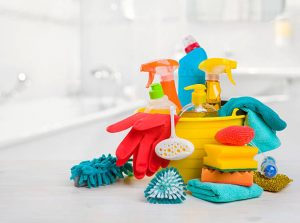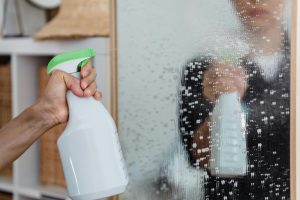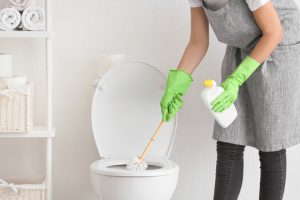Spring Cleaning is Here! Organize and Declutter Your Home Today.

Bathrooms often collect dust, so start by dusting the space. Before cleaning, use a duster to remove dust from countertops, toilet tanks, and windowsills. Cleaning isn’t just about the large sputter and visible spots can often be addressed with ease but is also important to focus on smaller areas that can be cleaned in no time.
A squeegee is an indispensable tool for maintaining a clean bathroom, and if you do not own one, now is the ideal time to acquire it. Regular use of a squeegee is highly effective in preventing water mineral deposits on bathroom mirrors. Dedicate approximately two minutes after each shower to wipe down tiles and mirrors, much like cleaning a car windshield. This practice helps to prevent mineral and Soap scum accumulation, minimizing frequency of intensive bathroom cleaning.
Mold and mildew in the can significantly alter its appearance. While chlorine bleach offers a solution, some individuals may find it unsuitable. In such cases, hydrogen peroxide serves as an excellent alternative. Simply fill a spray bottle with hydrogen peroxide, apply it to areas affected by mold and mildew, and rinse thoroughly.

Repurpose old toothbrushes as miniature cleaning tools for bathrooms is an excellent way to ensure every corner is spotless. Simply use some hot boiled water to soften the brush, then employ pliers or tweezers to bend half of the brush head backward. This creates a uniquely shaped tool ideal for accessing tight spaces. Additionally, baby oil can be a highly effective cleaning aid even if you do not have a baby.
For cleaning grout, an old electric toothbrush or one with an extra head can be particularly useful. Dampen the toothbrush head, dip in baking soda, and use it to scrub grout and other hard-to-reach areas. Baking soda serves as a mild abrasive, effectively removing soap scum and trapped dirt.
An effective grout-cleaning technique involves creating a paste by mixing baking soda and water. Apply this paste to stained grout lines, scrub using a small brush or an old toothbrush and rinse thoroughly with water.
For metal surfaces like faucets, begin by cleaning them with warm water. Then, apply a small amount of baby oil to a soft and wipe the surfaces to achieve a polished finish.
Puddles in the bathroom, unless during a shower, can pose significant risks. Slips in such areas are hazardous, and puddles increase this danger. Standing water also attracts insects and collects dust and hair. To prevent these problems, immediately dry any wet spots as soon as they appear.
Shaving cream not only protects the skin but also offers additional utility in the bathroom. a thin layer of shaving cream containing glycerine to your mirror can prevent fogging. Simply spread a thin coating and wipe it off with a soft cloth.

Dryer sheets are highly effective for removing soap scum from glass shower doors and tiles. Simply wet a few sheets and use them to wipe down these surfaces. The fabric softener in the sheets effectively loosens and clears soap scum.
Deep cleaning the showerhead can prevent sputtering and mess. A simple method involves distilled vinegar. Remove the showerhead and soak it in distilled white vinegar, which dissolves minerals clogging the jets and ensures a smooth flow. For a hands-free approach, fill a plastic bag with diluted white vinegar, secure it around the showerhead with rubber bands or a zippered plastic bag, and leave it overnight. The vinegar will dissolve mineral buildup. Many cleaners recommend a 50/50 solution of distilled white vinegar and water as a preventive measure. Spray it daily or every other day to inhibit soap scum accumulation in the shower.
Lemons are not only for lemonade but also excellent cleaning agents. Slice a lemon in half, sprinkle on one side, and use it as a scrubber. It works well on showerheads, faucets, and other metal fixtures. The citric acid effectively removes mineral deposits. If bathroom cleaners are unavailable, aspirin is a surprising alternative. The salicylic acid in aspirin acts as an efficient cleaning agent. Dissolve an aspirin tablet in water and use the solution like a standard cleaner to remove soap scum and stains in the shower.
For individuals living in areas with hard water, stubborn rings and streaks in the toilet bowl are a common challenge, often resistant to scrubbing and frequent cleaning. The high mineral content including calcium, iron, and magnesium can create rust-colored stains that are particularly difficult to remove. A solution involves mixing vinegar baking soda and using it periodically to prevent stains. Alternatively, borax paste can be applied for more persistent discoloration. 
Pumice stones, typically associated with pedicures, can also effectively remove tough stains from toilet bowls. Available in powder or liquid form, this abrasive is an economical method to eliminate hard water stains, limescale, and rust. To use, lower the water level in the toilet, wear gloves, and scrub thoroughly.
For an immediate rejuvenation of your toilet bowl, sprinkle oxygen inside and let it sit for about 15 minutes or. Scrub with a toilet brush, rinse, and flush to achieve a bright, clear white appearance.
It is also important to remember that toilet brushes require regular cleaning. Placing the brush back in its holder without it can lead to the growth of bacteria or mold. After use, disinfect the brush by spraying it with hydrogen peroxide and allow it to dry, such as by placing it under the toilet seat.